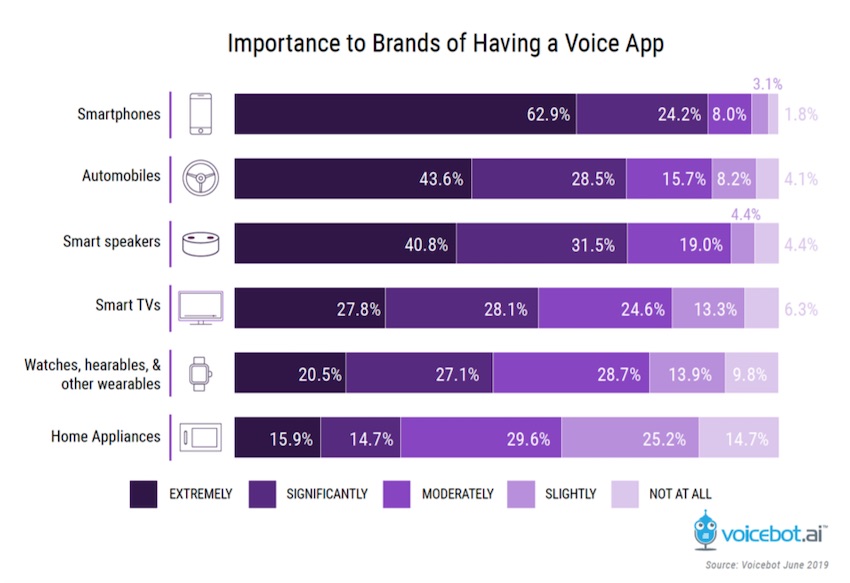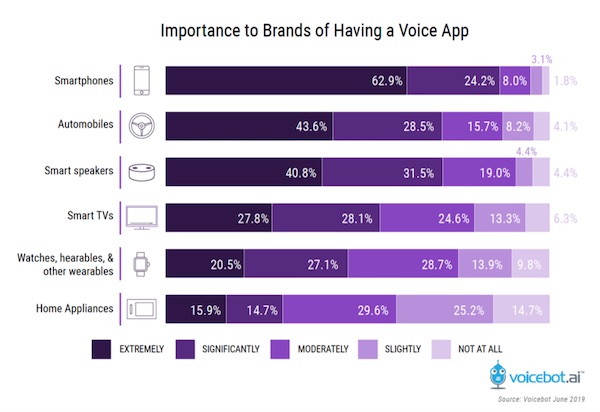Marketers View Voice Assistant Presence on Smartphones More Important Than on Smart Speakers
There is a lot of focus on the rapid adoption of smart speakers and how brands can use these household devices to reach consumers. However, in a recent survey of North American marketers by Voicebot and Voices.com, marketers prioritized having a voice assistant presence for the smartphone much higher than smart speakers.

Nearly 63% of marketers said having a voice app for smartphone users was “extremely important” compared to just 41% for smart speakers. That is a gap of over 20 percentage points. This disparity narrows by 7 percentage points when you add “significantly important” with the smartphone voice presence reaching 87% and smart speakers 72%. Notably, the “extremely important” category for voice assistant availability in cars also beats out smart speakers by a small margin and the two surfaces are at parity when adding the “significantly important” responses.
Smart speakers have become synonymous with voice assistants for many consumers, but marketers take a more analytical approach to any new channel. In this case, the fact that about 89% of U.S. adults own a smartphone and fewer than 30% have a smart speaker simply means that smartphones have much higher consumer reach. Voice assistants as marketing channels also have different characteristics by surface as smartphones are personal devices whereas smart speakers often serve multiple users. David Ciccarelli, CEO of Voices.com, commented on the data by saying:
“I think what we’re seeing here is marketers already have an iOS or an Android application and they understand their installed base. They’ve already had success with smartphones. So, perhaps what we’re seeing is an interest in leveraging and building off that existing installed base and using a platform surface that they’re already familiar with…Maybe it’s one voice command away from getting into commerce or some other call-to-action where you’re in marrying the auditory and visual elements yet still in a personalized experience.”
Marketers Want to Be Everywhere
Another striking aspect of the data is that a large number of marketers also see the benefit of having a presence on voice assistants for many more devices ranging from smart TVs and wearables to household appliances. Sixty percent saw marketing through household appliances such as dishwashers and microwaves as at least “moderately important” which suggests a marketer intent to be available on nearly every potential consumer touchpoint. Voicebot’s Ava Mutchler was surprised that more marketers didn’t rate smart TV’s higher than the 28% ranking these devices as “extremely important” for voice app presence. Mutchler commented on a Voicebot webinar:
“I was actually surprised that more marketers don’t see the potential for smart TVs because it’s a giant multimodal experience. As we saw at CES, the manufacturers are committed to having voice on your TV and getting rid of the remote entirely. This can lend itself to other apps and the immediate integration of television advertising with a simple call-to-action spoken by the consumer.”
You can learn more about marketer activity and sentiment around voice assistants as a channel for consumer reach in a recent webinar where the survey results were discussed in-depth. This discussion was also published as episode 108 of the Voicebot Podcast. You can download the full report complete with 20 charts and 30 pages of analysis here: Download
Follow @bretkinsella Follow @voicebotai
North American Marketers See Most Potential in Alexa Over Google Assistant by a Wide Margin
Marketer Adoption of Voice Apps as a Marketing Channel – Voicebot Podcast Ep 108









